Evaluating HRM Trends in Australia: Gig Economy, Outsourcing Impact
VerifiedAdded on 2023/06/07
|9
|2110
|404
Essay
AI Summary
This essay provides a comprehensive analysis of the evolving trends in Human Resource Management (HRM) within Australia, focusing on the impact of casualization, outsourcing, and the rise of the gig economy. It discusses how these trends are reshaping traditional employment models and affecting key stakeholders, including both employers and employees. The essay explores the challenges these trends pose to the existing Australian regulatory framework, particularly concerning labor laws and employee rights. It concludes by emphasizing the need for HR legislative frameworks to adapt to the changing nature of work in order to support fair pay, job security, and other essential aspects of employment in the context of the gig economy and outsourcing.
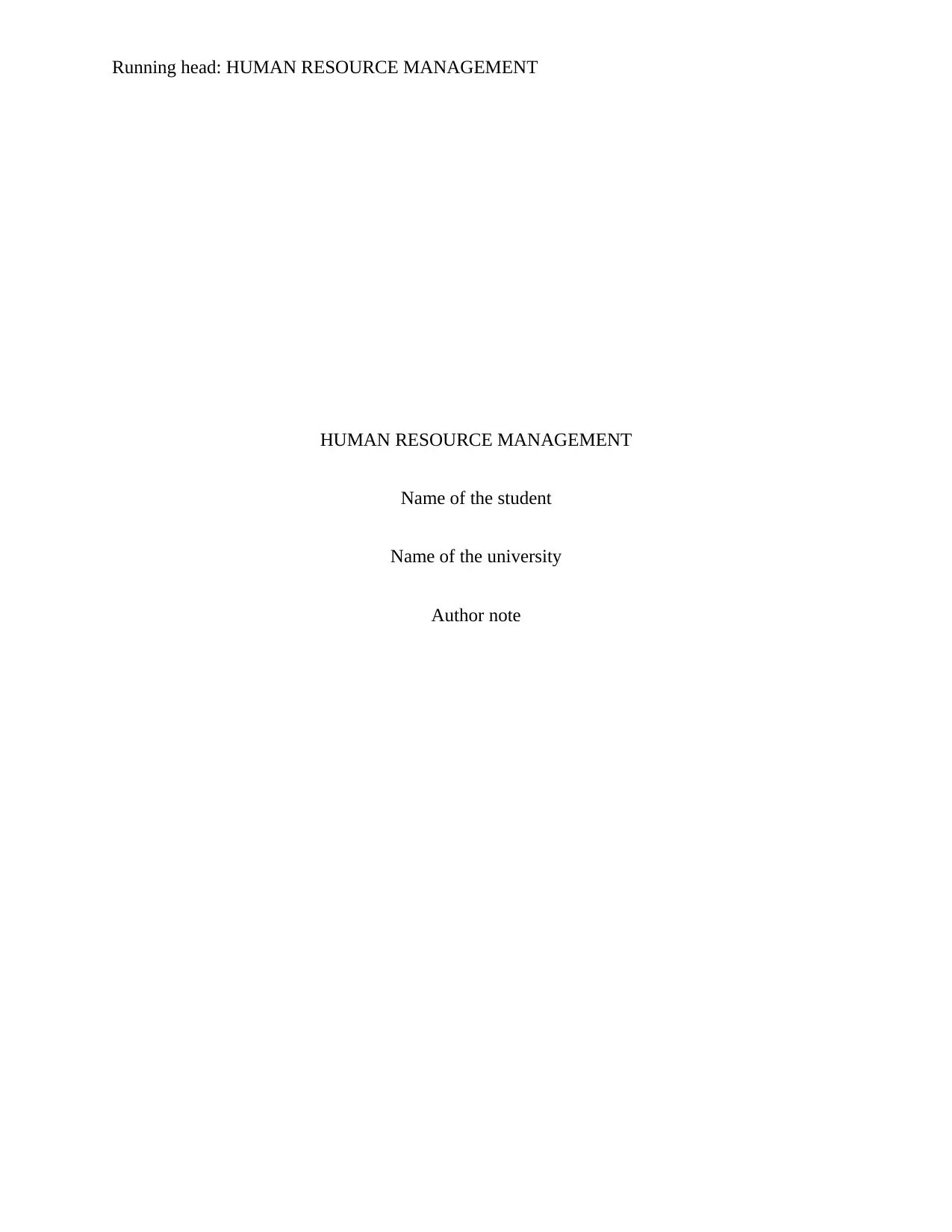
Running head: HUMAN RESOURCE MANAGEMENT
HUMAN RESOURCE MANAGEMENT
Name of the student
Name of the university
Author note
HUMAN RESOURCE MANAGEMENT
Name of the student
Name of the university
Author note
Secure Best Marks with AI Grader
Need help grading? Try our AI Grader for instant feedback on your assignments.
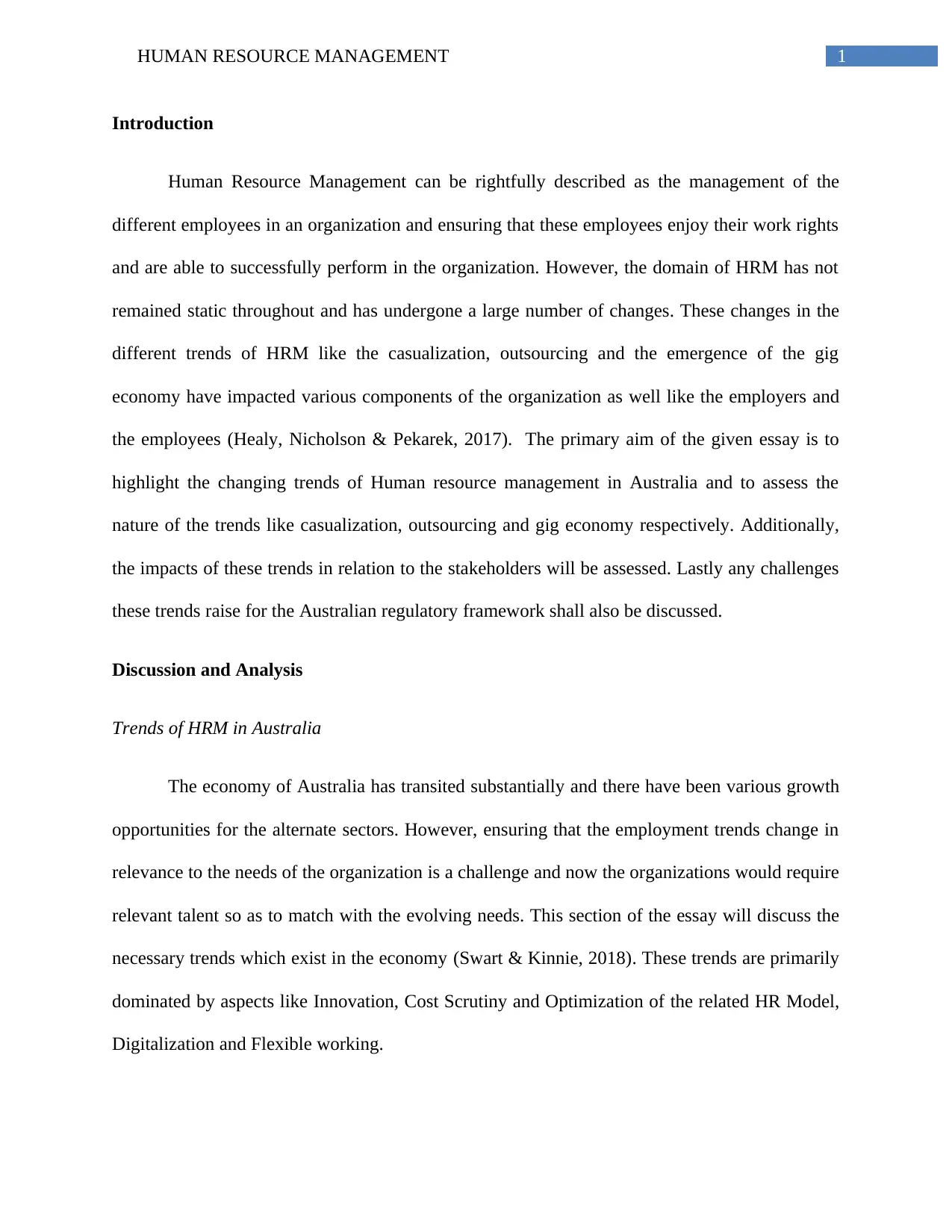
1HUMAN RESOURCE MANAGEMENT
Introduction
Human Resource Management can be rightfully described as the management of the
different employees in an organization and ensuring that these employees enjoy their work rights
and are able to successfully perform in the organization. However, the domain of HRM has not
remained static throughout and has undergone a large number of changes. These changes in the
different trends of HRM like the casualization, outsourcing and the emergence of the gig
economy have impacted various components of the organization as well like the employers and
the employees (Healy, Nicholson & Pekarek, 2017). The primary aim of the given essay is to
highlight the changing trends of Human resource management in Australia and to assess the
nature of the trends like casualization, outsourcing and gig economy respectively. Additionally,
the impacts of these trends in relation to the stakeholders will be assessed. Lastly any challenges
these trends raise for the Australian regulatory framework shall also be discussed.
Discussion and Analysis
Trends of HRM in Australia
The economy of Australia has transited substantially and there have been various growth
opportunities for the alternate sectors. However, ensuring that the employment trends change in
relevance to the needs of the organization is a challenge and now the organizations would require
relevant talent so as to match with the evolving needs. This section of the essay will discuss the
necessary trends which exist in the economy (Swart & Kinnie, 2018). These trends are primarily
dominated by aspects like Innovation, Cost Scrutiny and Optimization of the related HR Model,
Digitalization and Flexible working.
Introduction
Human Resource Management can be rightfully described as the management of the
different employees in an organization and ensuring that these employees enjoy their work rights
and are able to successfully perform in the organization. However, the domain of HRM has not
remained static throughout and has undergone a large number of changes. These changes in the
different trends of HRM like the casualization, outsourcing and the emergence of the gig
economy have impacted various components of the organization as well like the employers and
the employees (Healy, Nicholson & Pekarek, 2017). The primary aim of the given essay is to
highlight the changing trends of Human resource management in Australia and to assess the
nature of the trends like casualization, outsourcing and gig economy respectively. Additionally,
the impacts of these trends in relation to the stakeholders will be assessed. Lastly any challenges
these trends raise for the Australian regulatory framework shall also be discussed.
Discussion and Analysis
Trends of HRM in Australia
The economy of Australia has transited substantially and there have been various growth
opportunities for the alternate sectors. However, ensuring that the employment trends change in
relevance to the needs of the organization is a challenge and now the organizations would require
relevant talent so as to match with the evolving needs. This section of the essay will discuss the
necessary trends which exist in the economy (Swart & Kinnie, 2018). These trends are primarily
dominated by aspects like Innovation, Cost Scrutiny and Optimization of the related HR Model,
Digitalization and Flexible working.
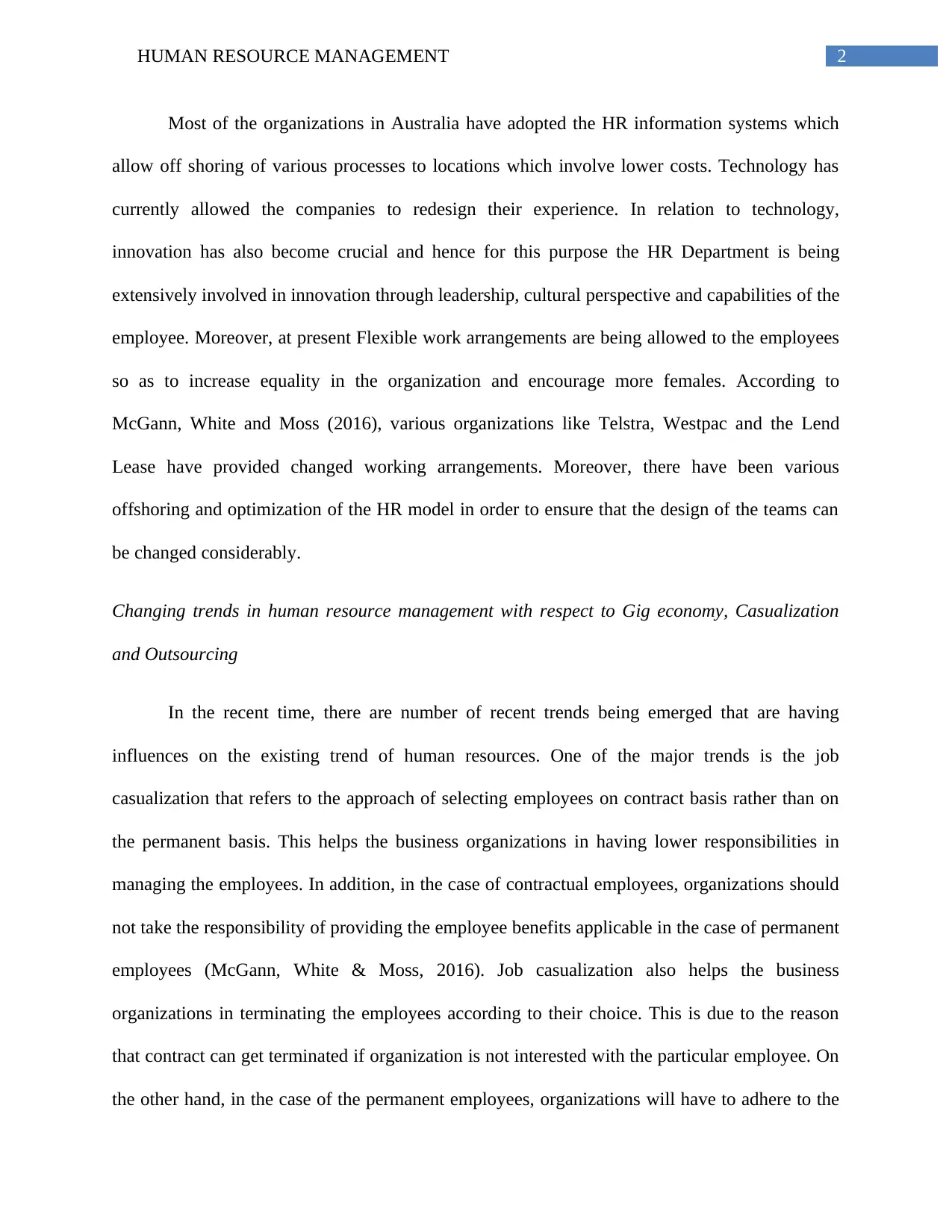
2HUMAN RESOURCE MANAGEMENT
Most of the organizations in Australia have adopted the HR information systems which
allow off shoring of various processes to locations which involve lower costs. Technology has
currently allowed the companies to redesign their experience. In relation to technology,
innovation has also become crucial and hence for this purpose the HR Department is being
extensively involved in innovation through leadership, cultural perspective and capabilities of the
employee. Moreover, at present Flexible work arrangements are being allowed to the employees
so as to increase equality in the organization and encourage more females. According to
McGann, White and Moss (2016), various organizations like Telstra, Westpac and the Lend
Lease have provided changed working arrangements. Moreover, there have been various
offshoring and optimization of the HR model in order to ensure that the design of the teams can
be changed considerably.
Changing trends in human resource management with respect to Gig economy, Casualization
and Outsourcing
In the recent time, there are number of recent trends being emerged that are having
influences on the existing trend of human resources. One of the major trends is the job
casualization that refers to the approach of selecting employees on contract basis rather than on
the permanent basis. This helps the business organizations in having lower responsibilities in
managing the employees. In addition, in the case of contractual employees, organizations should
not take the responsibility of providing the employee benefits applicable in the case of permanent
employees (McGann, White & Moss, 2016). Job casualization also helps the business
organizations in terminating the employees according to their choice. This is due to the reason
that contract can get terminated if organization is not interested with the particular employee. On
the other hand, in the case of the permanent employees, organizations will have to adhere to the
Most of the organizations in Australia have adopted the HR information systems which
allow off shoring of various processes to locations which involve lower costs. Technology has
currently allowed the companies to redesign their experience. In relation to technology,
innovation has also become crucial and hence for this purpose the HR Department is being
extensively involved in innovation through leadership, cultural perspective and capabilities of the
employee. Moreover, at present Flexible work arrangements are being allowed to the employees
so as to increase equality in the organization and encourage more females. According to
McGann, White and Moss (2016), various organizations like Telstra, Westpac and the Lend
Lease have provided changed working arrangements. Moreover, there have been various
offshoring and optimization of the HR model in order to ensure that the design of the teams can
be changed considerably.
Changing trends in human resource management with respect to Gig economy, Casualization
and Outsourcing
In the recent time, there are number of recent trends being emerged that are having
influences on the existing trend of human resources. One of the major trends is the job
casualization that refers to the approach of selecting employees on contract basis rather than on
the permanent basis. This helps the business organizations in having lower responsibilities in
managing the employees. In addition, in the case of contractual employees, organizations should
not take the responsibility of providing the employee benefits applicable in the case of permanent
employees (McGann, White & Moss, 2016). Job casualization also helps the business
organizations in terminating the employees according to their choice. This is due to the reason
that contract can get terminated if organization is not interested with the particular employee. On
the other hand, in the case of the permanent employees, organizations will have to adhere to the
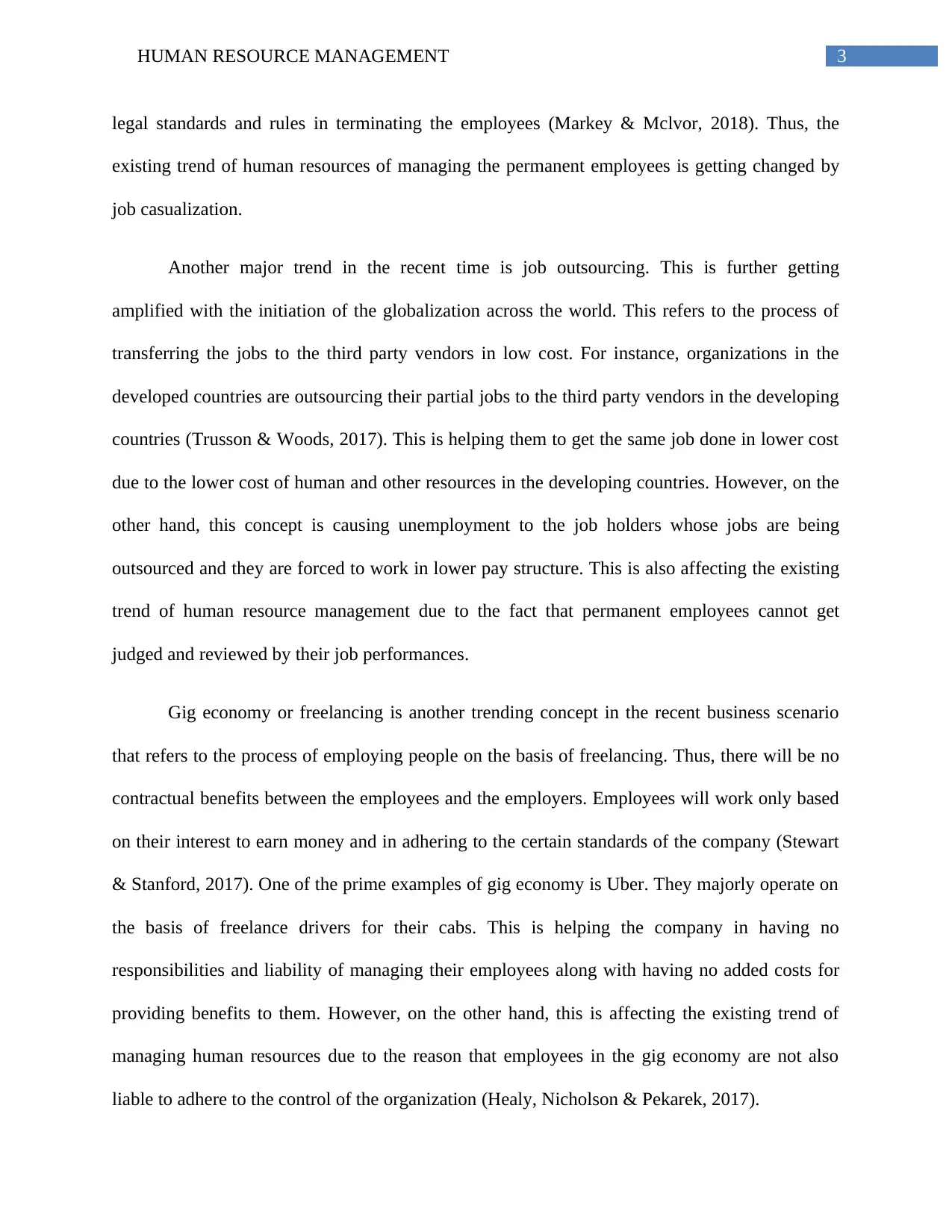
3HUMAN RESOURCE MANAGEMENT
legal standards and rules in terminating the employees (Markey & Mclvor, 2018). Thus, the
existing trend of human resources of managing the permanent employees is getting changed by
job casualization.
Another major trend in the recent time is job outsourcing. This is further getting
amplified with the initiation of the globalization across the world. This refers to the process of
transferring the jobs to the third party vendors in low cost. For instance, organizations in the
developed countries are outsourcing their partial jobs to the third party vendors in the developing
countries (Trusson & Woods, 2017). This is helping them to get the same job done in lower cost
due to the lower cost of human and other resources in the developing countries. However, on the
other hand, this concept is causing unemployment to the job holders whose jobs are being
outsourced and they are forced to work in lower pay structure. This is also affecting the existing
trend of human resource management due to the fact that permanent employees cannot get
judged and reviewed by their job performances.
Gig economy or freelancing is another trending concept in the recent business scenario
that refers to the process of employing people on the basis of freelancing. Thus, there will be no
contractual benefits between the employees and the employers. Employees will work only based
on their interest to earn money and in adhering to the certain standards of the company (Stewart
& Stanford, 2017). One of the prime examples of gig economy is Uber. They majorly operate on
the basis of freelance drivers for their cabs. This is helping the company in having no
responsibilities and liability of managing their employees along with having no added costs for
providing benefits to them. However, on the other hand, this is affecting the existing trend of
managing human resources due to the reason that employees in the gig economy are not also
liable to adhere to the control of the organization (Healy, Nicholson & Pekarek, 2017).
legal standards and rules in terminating the employees (Markey & Mclvor, 2018). Thus, the
existing trend of human resources of managing the permanent employees is getting changed by
job casualization.
Another major trend in the recent time is job outsourcing. This is further getting
amplified with the initiation of the globalization across the world. This refers to the process of
transferring the jobs to the third party vendors in low cost. For instance, organizations in the
developed countries are outsourcing their partial jobs to the third party vendors in the developing
countries (Trusson & Woods, 2017). This is helping them to get the same job done in lower cost
due to the lower cost of human and other resources in the developing countries. However, on the
other hand, this concept is causing unemployment to the job holders whose jobs are being
outsourced and they are forced to work in lower pay structure. This is also affecting the existing
trend of human resource management due to the fact that permanent employees cannot get
judged and reviewed by their job performances.
Gig economy or freelancing is another trending concept in the recent business scenario
that refers to the process of employing people on the basis of freelancing. Thus, there will be no
contractual benefits between the employees and the employers. Employees will work only based
on their interest to earn money and in adhering to the certain standards of the company (Stewart
& Stanford, 2017). One of the prime examples of gig economy is Uber. They majorly operate on
the basis of freelance drivers for their cabs. This is helping the company in having no
responsibilities and liability of managing their employees along with having no added costs for
providing benefits to them. However, on the other hand, this is affecting the existing trend of
managing human resources due to the reason that employees in the gig economy are not also
liable to adhere to the control of the organization (Healy, Nicholson & Pekarek, 2017).
Secure Best Marks with AI Grader
Need help grading? Try our AI Grader for instant feedback on your assignments.
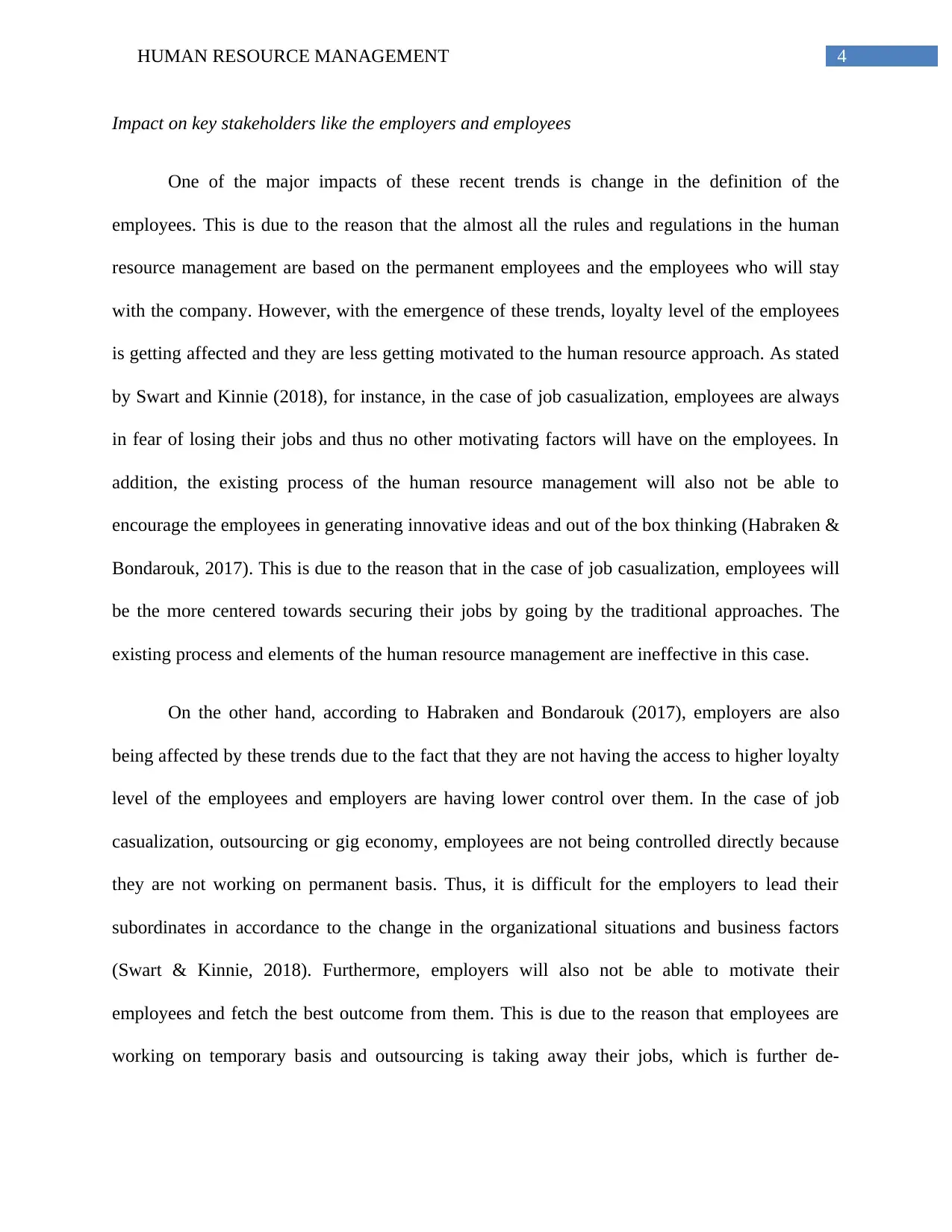
4HUMAN RESOURCE MANAGEMENT
Impact on key stakeholders like the employers and employees
One of the major impacts of these recent trends is change in the definition of the
employees. This is due to the reason that the almost all the rules and regulations in the human
resource management are based on the permanent employees and the employees who will stay
with the company. However, with the emergence of these trends, loyalty level of the employees
is getting affected and they are less getting motivated to the human resource approach. As stated
by Swart and Kinnie (2018), for instance, in the case of job casualization, employees are always
in fear of losing their jobs and thus no other motivating factors will have on the employees. In
addition, the existing process of the human resource management will also not be able to
encourage the employees in generating innovative ideas and out of the box thinking (Habraken &
Bondarouk, 2017). This is due to the reason that in the case of job casualization, employees will
be the more centered towards securing their jobs by going by the traditional approaches. The
existing process and elements of the human resource management are ineffective in this case.
On the other hand, according to Habraken and Bondarouk (2017), employers are also
being affected by these trends due to the fact that they are not having the access to higher loyalty
level of the employees and employers are having lower control over them. In the case of job
casualization, outsourcing or gig economy, employees are not being controlled directly because
they are not working on permanent basis. Thus, it is difficult for the employers to lead their
subordinates in accordance to the change in the organizational situations and business factors
(Swart & Kinnie, 2018). Furthermore, employers will also not be able to motivate their
employees and fetch the best outcome from them. This is due to the reason that employees are
working on temporary basis and outsourcing is taking away their jobs, which is further de-
Impact on key stakeholders like the employers and employees
One of the major impacts of these recent trends is change in the definition of the
employees. This is due to the reason that the almost all the rules and regulations in the human
resource management are based on the permanent employees and the employees who will stay
with the company. However, with the emergence of these trends, loyalty level of the employees
is getting affected and they are less getting motivated to the human resource approach. As stated
by Swart and Kinnie (2018), for instance, in the case of job casualization, employees are always
in fear of losing their jobs and thus no other motivating factors will have on the employees. In
addition, the existing process of the human resource management will also not be able to
encourage the employees in generating innovative ideas and out of the box thinking (Habraken &
Bondarouk, 2017). This is due to the reason that in the case of job casualization, employees will
be the more centered towards securing their jobs by going by the traditional approaches. The
existing process and elements of the human resource management are ineffective in this case.
On the other hand, according to Habraken and Bondarouk (2017), employers are also
being affected by these trends due to the fact that they are not having the access to higher loyalty
level of the employees and employers are having lower control over them. In the case of job
casualization, outsourcing or gig economy, employees are not being controlled directly because
they are not working on permanent basis. Thus, it is difficult for the employers to lead their
subordinates in accordance to the change in the organizational situations and business factors
(Swart & Kinnie, 2018). Furthermore, employers will also not be able to motivate their
employees and fetch the best outcome from them. This is due to the reason that employees are
working on temporary basis and outsourcing is taking away their jobs, which is further de-
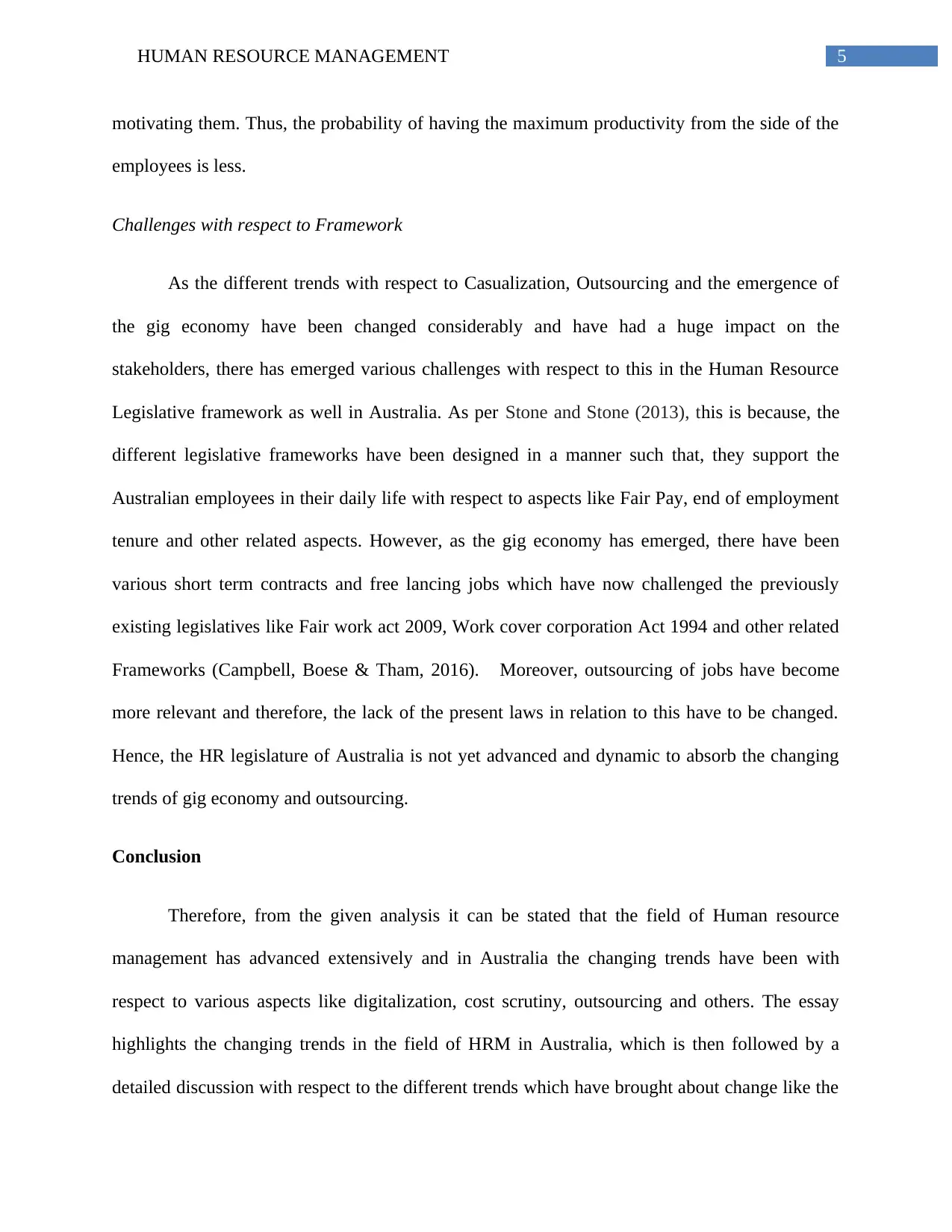
5HUMAN RESOURCE MANAGEMENT
motivating them. Thus, the probability of having the maximum productivity from the side of the
employees is less.
Challenges with respect to Framework
As the different trends with respect to Casualization, Outsourcing and the emergence of
the gig economy have been changed considerably and have had a huge impact on the
stakeholders, there has emerged various challenges with respect to this in the Human Resource
Legislative framework as well in Australia. As per Stone and Stone (2013), this is because, the
different legislative frameworks have been designed in a manner such that, they support the
Australian employees in their daily life with respect to aspects like Fair Pay, end of employment
tenure and other related aspects. However, as the gig economy has emerged, there have been
various short term contracts and free lancing jobs which have now challenged the previously
existing legislatives like Fair work act 2009, Work cover corporation Act 1994 and other related
Frameworks (Campbell, Boese & Tham, 2016). Moreover, outsourcing of jobs have become
more relevant and therefore, the lack of the present laws in relation to this have to be changed.
Hence, the HR legislature of Australia is not yet advanced and dynamic to absorb the changing
trends of gig economy and outsourcing.
Conclusion
Therefore, from the given analysis it can be stated that the field of Human resource
management has advanced extensively and in Australia the changing trends have been with
respect to various aspects like digitalization, cost scrutiny, outsourcing and others. The essay
highlights the changing trends in the field of HRM in Australia, which is then followed by a
detailed discussion with respect to the different trends which have brought about change like the
motivating them. Thus, the probability of having the maximum productivity from the side of the
employees is less.
Challenges with respect to Framework
As the different trends with respect to Casualization, Outsourcing and the emergence of
the gig economy have been changed considerably and have had a huge impact on the
stakeholders, there has emerged various challenges with respect to this in the Human Resource
Legislative framework as well in Australia. As per Stone and Stone (2013), this is because, the
different legislative frameworks have been designed in a manner such that, they support the
Australian employees in their daily life with respect to aspects like Fair Pay, end of employment
tenure and other related aspects. However, as the gig economy has emerged, there have been
various short term contracts and free lancing jobs which have now challenged the previously
existing legislatives like Fair work act 2009, Work cover corporation Act 1994 and other related
Frameworks (Campbell, Boese & Tham, 2016). Moreover, outsourcing of jobs have become
more relevant and therefore, the lack of the present laws in relation to this have to be changed.
Hence, the HR legislature of Australia is not yet advanced and dynamic to absorb the changing
trends of gig economy and outsourcing.
Conclusion
Therefore, from the given analysis it can be stated that the field of Human resource
management has advanced extensively and in Australia the changing trends have been with
respect to various aspects like digitalization, cost scrutiny, outsourcing and others. The essay
highlights the changing trends in the field of HRM in Australia, which is then followed by a
detailed discussion with respect to the different trends which have brought about change like the
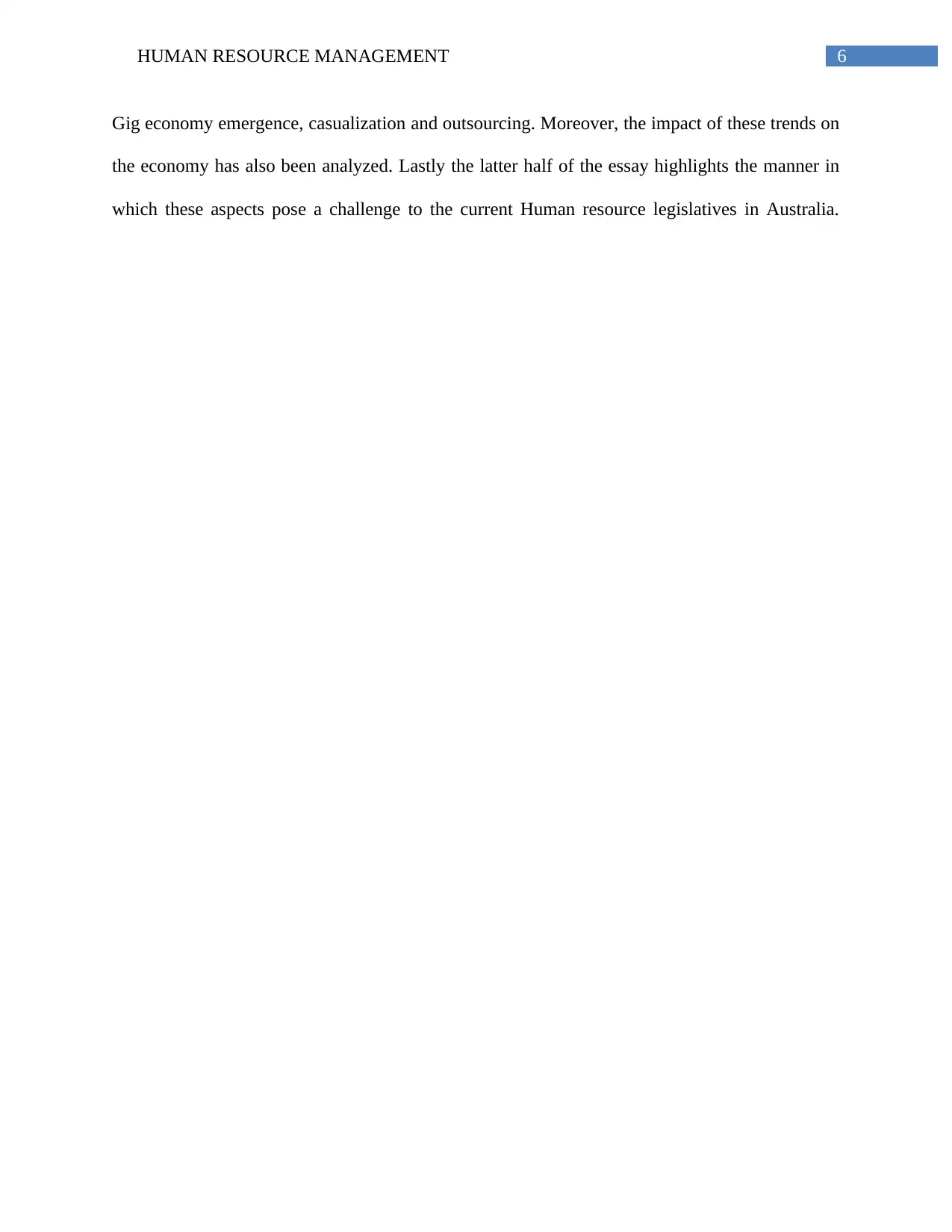
6HUMAN RESOURCE MANAGEMENT
Gig economy emergence, casualization and outsourcing. Moreover, the impact of these trends on
the economy has also been analyzed. Lastly the latter half of the essay highlights the manner in
which these aspects pose a challenge to the current Human resource legislatives in Australia.
Gig economy emergence, casualization and outsourcing. Moreover, the impact of these trends on
the economy has also been analyzed. Lastly the latter half of the essay highlights the manner in
which these aspects pose a challenge to the current Human resource legislatives in Australia.
Paraphrase This Document
Need a fresh take? Get an instant paraphrase of this document with our AI Paraphraser
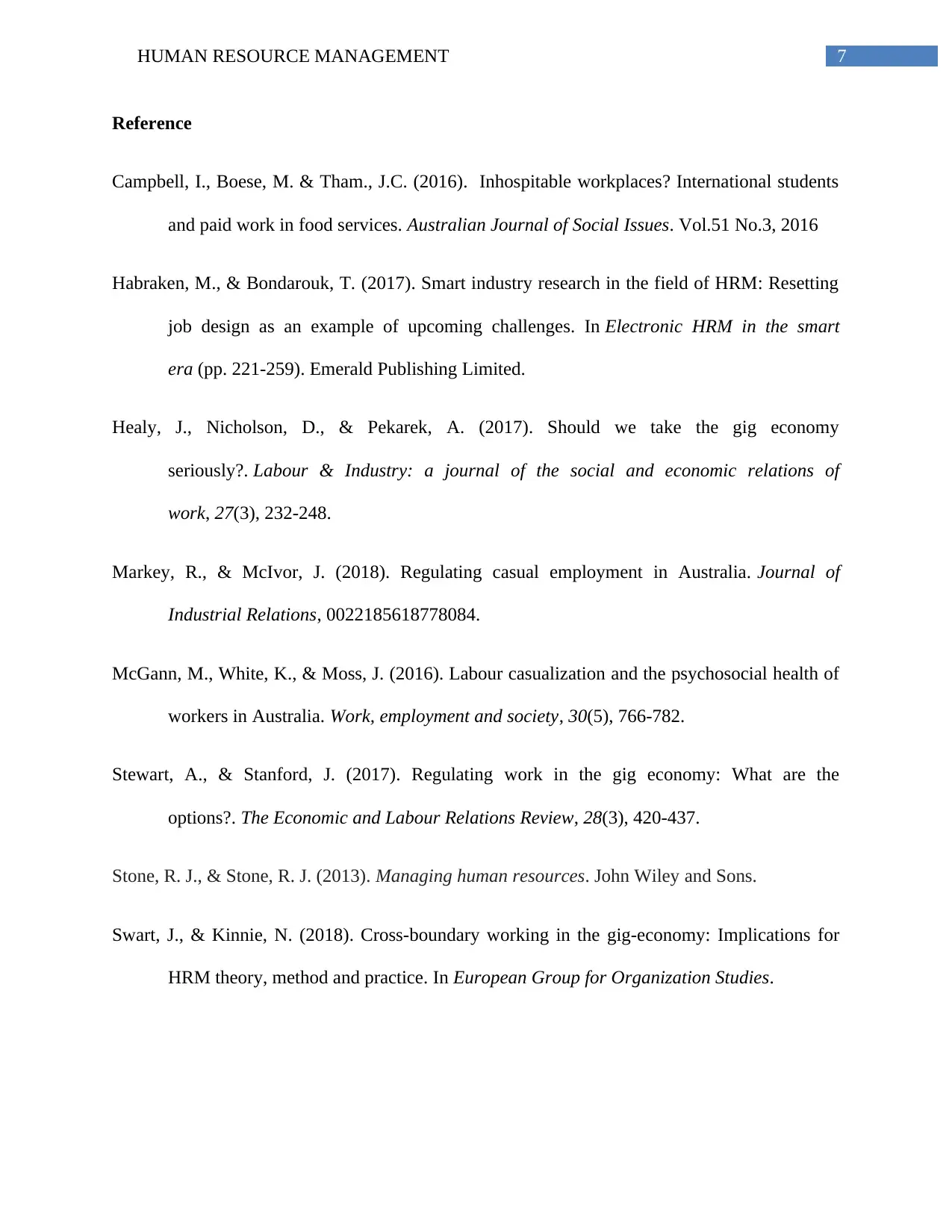
7HUMAN RESOURCE MANAGEMENT
Reference
Campbell, I., Boese, M. & Tham., J.C. (2016). Inhospitable workplaces? International students
and paid work in food services. Australian Journal of Social Issues. Vol.51 No.3, 2016
Habraken, M., & Bondarouk, T. (2017). Smart industry research in the field of HRM: Resetting
job design as an example of upcoming challenges. In Electronic HRM in the smart
era (pp. 221-259). Emerald Publishing Limited.
Healy, J., Nicholson, D., & Pekarek, A. (2017). Should we take the gig economy
seriously?. Labour & Industry: a journal of the social and economic relations of
work, 27(3), 232-248.
Markey, R., & McIvor, J. (2018). Regulating casual employment in Australia. Journal of
Industrial Relations, 0022185618778084.
McGann, M., White, K., & Moss, J. (2016). Labour casualization and the psychosocial health of
workers in Australia. Work, employment and society, 30(5), 766-782.
Stewart, A., & Stanford, J. (2017). Regulating work in the gig economy: What are the
options?. The Economic and Labour Relations Review, 28(3), 420-437.
Stone, R. J., & Stone, R. J. (2013). Managing human resources. John Wiley and Sons.
Swart, J., & Kinnie, N. (2018). Cross-boundary working in the gig-economy: Implications for
HRM theory, method and practice. In European Group for Organization Studies.
Reference
Campbell, I., Boese, M. & Tham., J.C. (2016). Inhospitable workplaces? International students
and paid work in food services. Australian Journal of Social Issues. Vol.51 No.3, 2016
Habraken, M., & Bondarouk, T. (2017). Smart industry research in the field of HRM: Resetting
job design as an example of upcoming challenges. In Electronic HRM in the smart
era (pp. 221-259). Emerald Publishing Limited.
Healy, J., Nicholson, D., & Pekarek, A. (2017). Should we take the gig economy
seriously?. Labour & Industry: a journal of the social and economic relations of
work, 27(3), 232-248.
Markey, R., & McIvor, J. (2018). Regulating casual employment in Australia. Journal of
Industrial Relations, 0022185618778084.
McGann, M., White, K., & Moss, J. (2016). Labour casualization and the psychosocial health of
workers in Australia. Work, employment and society, 30(5), 766-782.
Stewart, A., & Stanford, J. (2017). Regulating work in the gig economy: What are the
options?. The Economic and Labour Relations Review, 28(3), 420-437.
Stone, R. J., & Stone, R. J. (2013). Managing human resources. John Wiley and Sons.
Swart, J., & Kinnie, N. (2018). Cross-boundary working in the gig-economy: Implications for
HRM theory, method and practice. In European Group for Organization Studies.
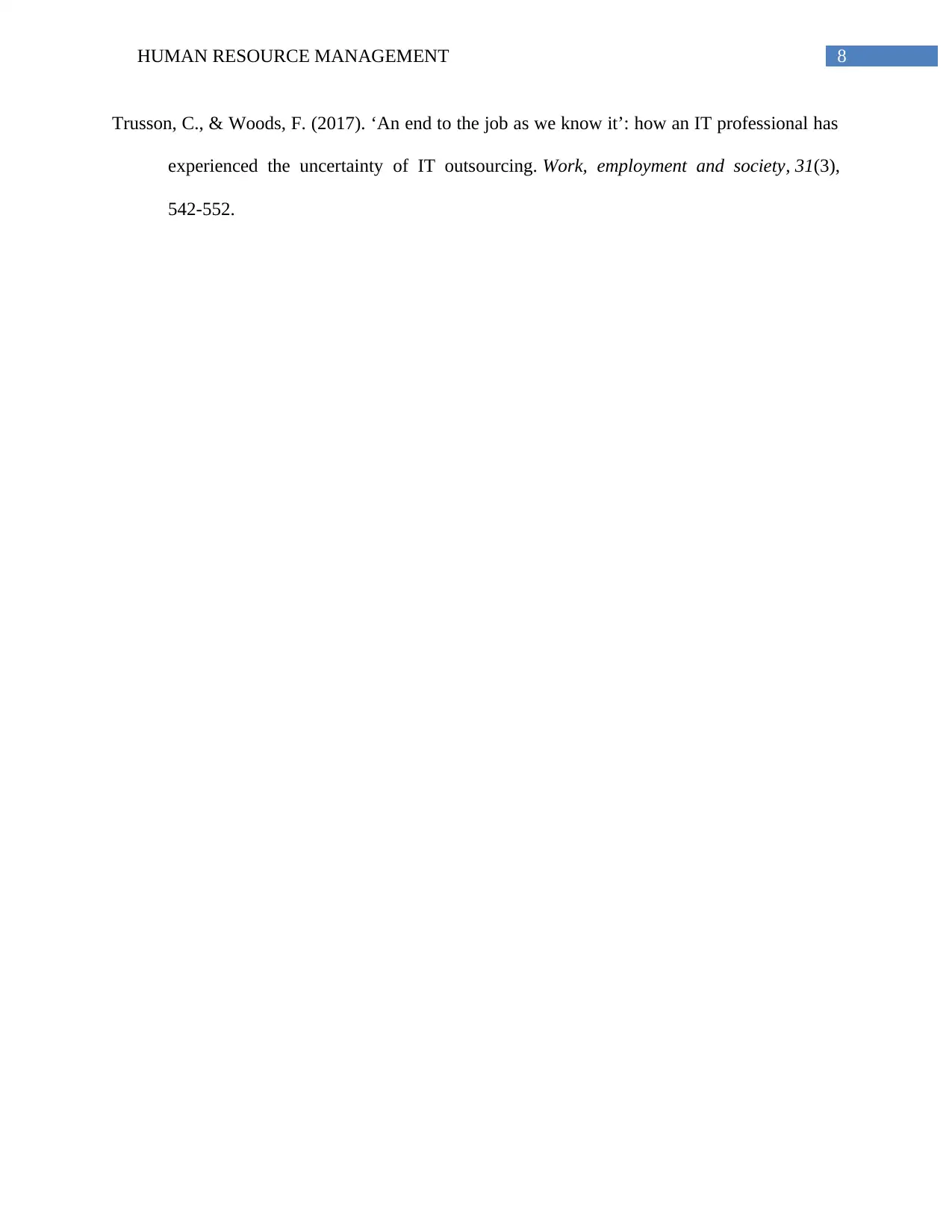
8HUMAN RESOURCE MANAGEMENT
Trusson, C., & Woods, F. (2017). ‘An end to the job as we know it’: how an IT professional has
experienced the uncertainty of IT outsourcing. Work, employment and society, 31(3),
542-552.
Trusson, C., & Woods, F. (2017). ‘An end to the job as we know it’: how an IT professional has
experienced the uncertainty of IT outsourcing. Work, employment and society, 31(3),
542-552.
1 out of 9
Related Documents
Your All-in-One AI-Powered Toolkit for Academic Success.
+13062052269
info@desklib.com
Available 24*7 on WhatsApp / Email
![[object Object]](/_next/static/media/star-bottom.7253800d.svg)
Unlock your academic potential
© 2024 | Zucol Services PVT LTD | All rights reserved.





